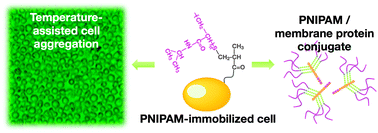Surface modification of mammalian cells with stimuli-responsive polymers†
Abstract
In order to introduce alternative functions into mammalian cells and control them under ambient conditions, poly(N-isopropyl acrylamide) (PNIPAM) was immobilized on the cell surface. Cellular aggregation could be regulated by temperature change. In addition, separation of PNIPAM-conjugated


 Please wait while we load your content...
Please wait while we load your content...